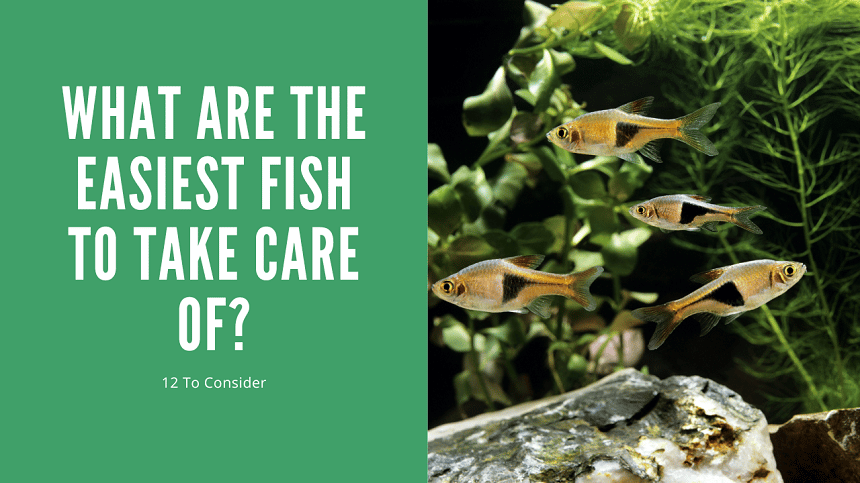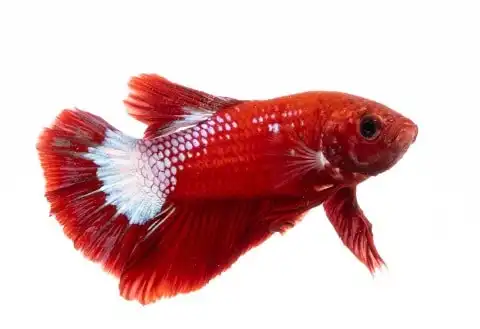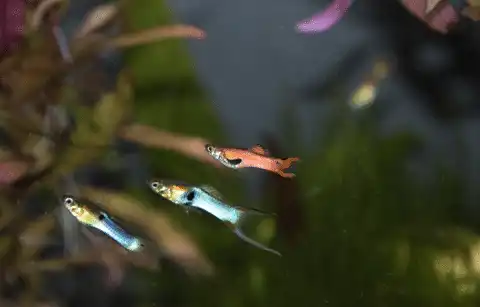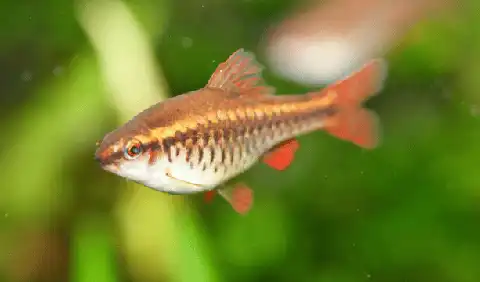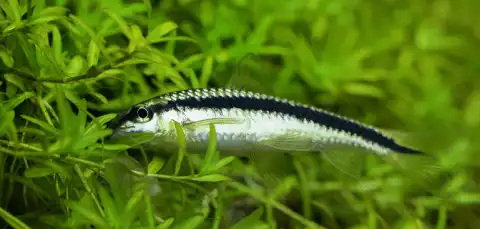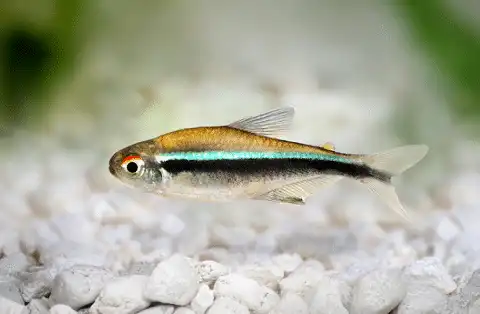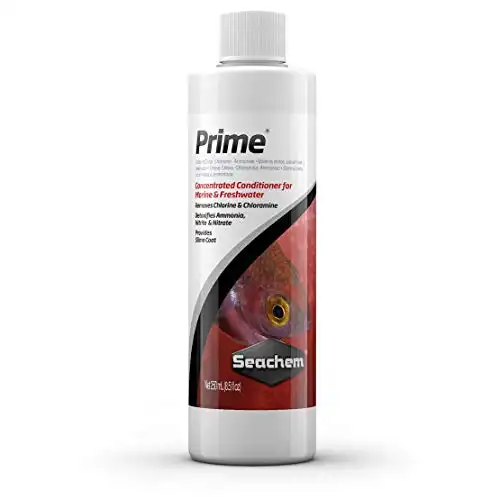Thank you for visiting! By the way… any links on this page that lead to products on Amazon and other stores/partners are affiliate links Aquarium Store Depot earns a commission if you make a purchase.
Are you just starting out in the fascinating world of fishkeeping? You’re probably looking for some great beginner fish that are easy to care for. With all the different species available in the hobby, choosing the best fish for your tank can be tough!
In this article, I’ll teach you about 12 types of fish that are perfect for your first fish tank, and a few that should be left for more experienced aquarists.
So let’s get started!
12 Simple Species To Take Care Of
Now that you know more about the benefits of keeping low-maintenance fish, it’s time to dive straight in and meet 12 awesome fish species you can keep!
Check out this video below from our YouTube channel. We go over more detail in the blog post below.
Each species profile includes a list of important facts, so take note of the following:
- Scientific name
- Temperament
- Origin
- Size
- Minimum Tank Size
- Diet
- pH
- Temperature
- Difficulty to breed
1. Betta
Use Coupon Code ASDFISH at Checkout
Betta Fish are one of the most beautiful varieties of freshwater fish available in the hobby. Easy to care for with plenty of varieties!
- Scientific name: Betta splendens
- Temperament: Aggressive
- Origin: Southeast Asia
- Size: 2.5 inches
- Minimum Tank Size: 5 gallons
- Diet: Feed granules, pellets, flakes, brine shrimp & blood worms
- pH: 6.5-7.5
- Temperature: 75-82°F
- Difficulty to breed: Moderate
The good old betta fish is a great species to start our list with. Betta fish are also called Siamese fighting fish because if you keep more than one male in the same tank, you can expect a war!
These colorful fish make great beginners fish because they don’t need a large fish tank and they’re really fun to keep. Betta fish can be kept with other community fish, but many beginners prefer to keep one of these beautiful tropical fish in its own tank.
2. White Cloud Minnows
A very peaceful fish that does well in coldwater fish. Other minnow varieties are also available
- Scientific name: Tanichthys albonubes
- Temperament: Peaceful
- Origin: China
- Size: 1.5 inches
- Minimum Tank Size: 10 gallons
- Diet: Feed granules, pellets, flakes
- pH: 6-8.5
- Temperature: 58-72°F
- Difficulty to breed: Moderate
The peaceful white cloud minnow is not actually a tropical fish. This means they don’t necessarily need a heater unless your home is really, really cold. These cold-water fish have great colors and they’re very peaceful, making them awesome fish species for beginners!
White cloud minnows don’t need a big tank, and they get along great with other fish. Just remember that these fish like it a little cooler than many other fish.
3. Danios

- Scientific name: Brachydanio rerio etc.
- Temperament: Peaceful
- Origin: Asia
- Size: 1.5-5 inches
- Minimum Tank Size: 15-30 gallons
- Diet: Feed pellets, granules, flakes, and live/frozen foods
- pH: 6-8
- Temperature: 65-77°F
- Difficulty to breed: Moderate
There are loads of beautiful danio species in the aquarium trade, and many of them are perfect beginner fish! Zebra danios are a great example, and they’re usually very easy to find.
These active little fish also come in spotted (leopard) and long-finned forms. Zebra danios are really peaceful and super hardy fish, but give them a nice big tank because they do prefer plenty of room to swim.
4. Endler’s Livebearer
A very active and colorful livebearer. Smaller in size than guppies
- Scientific name: Poecilia wingei
- Temperament: Peaceful
- Origin: South America
- Size: 1.5 inches
- Minimum Tank Size: 10 gallons
- Diet: Feed granules, pellets, flakes
- pH: 7-8.5
- Temperature: 75-86°F
- Difficulty to breed: Easy
The Endler’s livebearer is similar to a regular guppy, but they stay even smaller. These fish are super easy to care for, and they have amazing colors too!
These very small fish are called livebearers because the females give birth to live baby fish instead of laying eggs. They are one of the easiest fish to breed, but if you prefer not to have loads of tiny fish in your tank, go ahead and pick up just males, or just females. If you want to go larger, you can try platys or molly fish.
5. Kuhli Loach
Kuhli Loaches are hardy bottom-dwelling fish. Nocturnal in nature. Gets along with many fish and tolerate of coldwater environments
- Scientific name: Pangio semicincta
- Temperament: Peaceful
- Origin: Southeast Asia
- Size: 3.5-4 inches
- Minimum Tank Size: 15 gallons
- Diet: feed sinking tablets and frozen foods
- pH: 3.5-7
- Temperature: 70-79°F
- Difficulty to breed: Advanced
Kuhli loaches are super hardy and super easy to care for. They prefer to come out after dark, and they’re pretty shy, so I wouldn’t recommend these guys if you’re only looking for only one species.
For a community tank, however, kuhli loaches are great because they are always willing to pick up any scraps of uneaten food and help keep your aquarium clean.
6. Bristle Nose Pleco
The Bristlenose Pleco is a smaller Pleco that does a great job of eating algae. Peaceful and gets along with most fish
- Scientific name: Ancistrus spp.
- Temperament: Peaceful
- Origin: South America
- Size: 5 inches
- Minimum Tank Size: 30 gallons
- Diet: Feed sinking tablets, algae wafers, and plant material
- pH: 6.5-7.4
- Temperature: 70-78°F
- Difficulty to breed: Moderate
The bristle nose pleco is a really cool-looking bottom-dweller fish that is very easy to keep. These small fish are also known as the bushy nose pleco because males develop strange bushy growths on their faces.
Bristle nose plecos are suckerfish, and they love eating algae off driftwood and the glass walls of the aquarium. There are both the regular and albino varieties available.
7. Harlequin Rasbora
A peaceful schooling fish. An ideal community fish. A great beginner fish
- Scientific name: Trigonostigma heteromorpha
- Temperament: Peaceful
- Origin: Southeast Asia
- Size: 1.25-1.75 inches
- Minimum Tank Size: 15 gallons
- Diet: Feed granules, flakes, and frozen/live foods
- pH: 5-7.5
- Temperature: 70-82°F
- Difficulty to breed: Moderate
The harlequin rasbora is a really good beginner fish. These reddish schooling fish have great triangular markings on their sides, just like the shape of a pork chop!
Harlequin rasboras are very easy fish to keep, and they love to have live plants in their tanks. They get along really well with other fish species too, but they should not be kept with more aggressive fish.
8. Albino Corydoras Catfish

- Scientific name: Corydoras spp.
- Temperament: Peaceful
- Origin: South America
- Size: 2-3 inches
- Minimum Tank Size: 15-30 gallons
- Diet: Feed pellets, tablets, and live/frozen foods
- pH: 7-8
- Temperature: 74-80°F
- Difficulty to breed: Advanced
Cory catfish are some of the best beginner fish in the hobby, and albinos are especially cool. These brightly colored little catfish are always easy to find, and they are very hardy. These neat little bottom feeders get along with all other peaceful fish, and they love picking up scraps at the bottom of the tank.
Like siamese fighting fish, cory fish breathe atmospheric air, so don’t be surprised to see them shoot up to the surface to take a breath every now and then!
9. Cherry Barbs
- Scientific name: Puntius titteya
- Temperament: Peaceful
- Origin: Sri Lanka, Asia
- Size: 1.5-2 inches
- Minimum Tank Size: 15 gallons
- Diet: Feed granules, pellets, or flakes. Include some plant matter and live/frozen food
- pH: 6-8
- Temperature: 68-81°F
- Difficulty to breed: Moderate
Cherry barbs don’t quite live up to the bad reputation of some of the other barb species. These peaceful and interesting schooling fish are great for beginners because they are very low maintenance and thrive in a wide range of temperatures and water parameters. Cherry barbs are a great-looking fish species too, and the males are especially colorful fish.
10. Red Eye Tetra

- Scientific name: Moenkhausia sanctaefilomenae
- Temperament: Peaceful
- Origin: South America
- Size: 2.8 inches
- Minimum Tank Size: 20 gallons
- Diet: Feed granules, pellets, or flakes. Include some plant matter and live/frozen food
- pH: 6-8
- Temperature: 72-79°F
- Difficulty to breed: Moderate
The good old red monk or red-eye tetra is a very underrated freshwater fish that is perfect for beginner fish keepers. They grow a little larger than other common species like the neon tetra, so set them up with a nice big tank and plenty of swimming space.
Red monk tetras are very peaceful, hardy, and active fish. They are social creatures too, so it’s important to keep them in a school of at least 6 of their own species.
11. Siamese Algae Eater
A great algae-eating fish that is known for eating black beard algae. Grows up to 7 inches in length and requires a larger aquarium
- Scientific name: Crossocheilus oblongus
- Temperament: Peaceful
- Origin: Southeast Asia
- Size: 6 inches
- Minimum Tank Size: 20 gallons
- Diet: Algae
- pH: 6.5-8
- Temperature: 75-79°F
- Difficulty to breed: Advanced
Siamese algae eaters are pretty large but very peaceful fish. They are amazing for keeping your tank clean because they love to eat algae. These tropical fish might not be very colorful, but they have a cool body shape, almost like a shark!
12. Black Neon Tetra
A variant neon variety. More reliant than neon and cardinal tetras
- Scientific name: Hyphessobrycon herbertaxelrodi
- Temperament: Peaceful
- Origin: Brazil
- Size: 1.5 inches
- Minimum Tank Size: 15 gallons
- Diet: Feed granules, flakes, and live/frozen foods
- pH: 5-7.5
- Temperature: 68-82°F
- Difficulty to breed: Moderate
Black neon tetras are super hardy freshwater aquarium fish that are the perfect fish for beginners! They are completely peaceful tetras and get along really well with other species and tank mates.
Black neon tetras are naturally schooling fish, so make sure you pick up a group of at least 6 to really enjoy their natural behaviors.
Varieties To Avoid
Now that you know 12 of the best freshwater fish for a new aquarium owner, let’s take a minute to look at a few species to avoid. Now, these are all great fish, but they are a little better suited to more experienced fish keepers.
1. Goldfish

Many people think goldfish are for beginners, but this isn’t actually true. These fish come in loads of fancy goldfish varieties, but they are all the same species as regular goldfish.
Goldfish are coldwater fish so they definitely won’t be at home in your standard tropical community tanks. Goldfish also grow larger than many people think. At up to 6 inches, goldfishes produce a lot of waste, oh and they love to eat your live plants too!
2. Cichlids
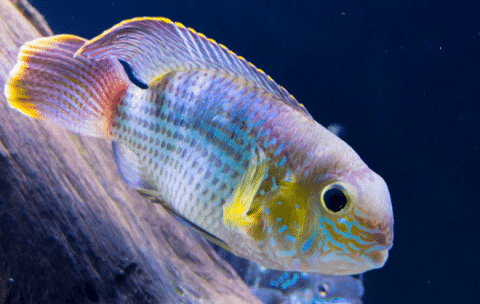
Cichlids tend to be aggressive and territorial fish. The African cichlids can be very aggressive and they usually need hard, alkaline water to be healthy. Large South American cichlids like oscar fish need loads of space, and they can be very aggressive too.
Some species, like angelfish, are pretty easy to keep, but as a general rule, cichlids should be avoided if you’re just starting out.
3. Freshwater Sharks
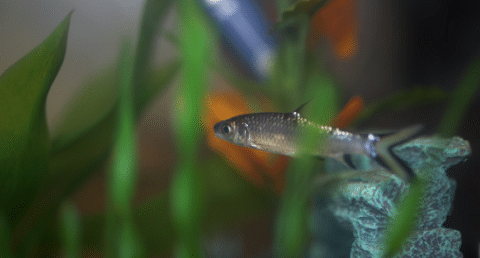
Freshwater sharks, like bala sharks, are another popular group of tropical fish that are not great for beginners. These fish aren’t actually true sharks, but they have a very similar shape.
Freshwater sharks can get really big, and some of them tend to get a bit mean towards other fish.
Why Choose Easy Fish?
When you’re starting out, it’s best to choose the easiest fish to take care of. Here’s why:
Your Enjoyment
Keeping fish should be fun! Keeping low-maintenance fish allows you to spend more time enjoying your pets.
Even easy fish need good care and regular maintenance, of course, but fish keeping shouldn’t feel like too much hard work, especially if you’re just getting started.
Time And Budget
You probably don’t have the time to be caring for your fish for hours every day. Costs can also add up pretty quickly when you start getting into the more advanced fish species.
So do yourself a favor and start out with a manageable aquarium with easy fish. You’ll enjoy the hobby so much more. Besides, you can always set up more tanks in the future!
The Health And Well Being Of Your Pets
Easy fish are much safer for beginner fish keepers because they are less likely to get sick. Of course, you want your pets to live long and healthy lives, so set yourself (and your fish) up for success with some easy and hardy beginner fish.
What Makes Some Fish Easy?
Why are some fish easier to keep than others? They’re all fish, right? Well, not quite…
Some species of fish are just much easier to keep than others! Let’s take a look at why:
Tank Size
Smaller fish aren’t necessarily easier to keep than big ones. Small aquariums can be a lot easier to set up and maintain, however. A massive aquarium is a very heavy thing, that needs careful planning to set up safely. Water is heavy, and performing water changes and keeping a large tank clean can be quite a lot of work.
This doesn’t mean you should go out and get a tiny aquarium, however. Very small tanks are difficult to manage too because the water parameters can swing so quickly. A tank of 20 to 30 gallons is a great size to start out with.
Water Quality
Easy fish are a little more forgiving when it comes to changes in water quality. If you’re just starting out, there’s a good chance you’ll make a mistake here and there. Easy fish are more likely to survive mistakes, but of course, you should always strive to keep your water quality as high as possible.
Parameters
Some fish need very specific water parameters to stay healthy. Maintaining these parameters can be tough. The easiest fish to take care of are adaptable to a wider range of conditions and parameters.
Diet
Some fish need really specific diets. Providing them with the fish food they need can be expensive, or take a lot of planning and effort. Fish that are easy to feed are much easier to keep.
Temperament
Peaceful fish are so much easier and less stressful to keep than aggressive species. Nobody wants their pets to fight and hurt each other, so choosing peaceful fish definitely makes for easier fish keeping.
Caring for Freshwater Varieties – A Crash Course
Keeping a beautiful fish tank full of healthy aquarium fish takes some careful research and solid planning. In this section, I’ll give you some good general information and tips about setting up your first fish tank.
Let’s get started!
Aquarium Set-Up Checklist
Before you can buy your first freshwater fish, you’re going to need to set up a great freshwater tank where they can live. These are the basic components of any fish tank setup:
Aquarium (with hood)
You’ll need to put your tank on a strong and perfectly level surface. A stand or cabinet is best for larger tanks.
Filter
This is really important for keeping your water clean and healthy. Buy a model that is rated to your tank size or larger.
Heater
This is very important for keeping your water temperature safe for tropical fish species. You’ll need a heater that matches your fish tank size, and be sure to adjust it to the perfect temperature for your fish.
Lighting
Your fish need a regular day/night cycle, but your tank should never be exposed to direct sunlight. Fluorescent or LED lamps with a timer are ideal.
Substrate
This is the aquarium-safe gravel or sand at the bottom of the tank. Fish tend to prefer darker colors, but you can choose the color that you like best!
Additional Items
Once you have put together a basic fish tank, you’re almost ready to go! There are a hundred and one other things that are used in aquariums, but you probably won’t need them yet. Nevertheless, there are still a few really important items that you’ll need to keep your fish healthy and your aquarium looking great.
Make sure you have all of the items on this list to get started in the right way!
Decorations
Decorations make empty fish tanks come to life! Fish love them too because they create hiding places and structures that the fish can swim around. Choose driftwood, natural stone, and a few cool ornaments to create a beautiful aquarium.
Water test kit
Test kits allow you to measure important water parameters like pH and nitrates that you can’t see or feel. This is very important for keeping your fish safe and healthy.
Water conditioner
Tap water usually contains harmful chemicals like chlorine. Water conditioner neutralizes these chemicals and makes the water safe for freshwater fish. A solution like Seachem AI Prime works great!
Seachem prime is a easy to use and affordable choice when it comes to remove chlorine and chloramines from your tap water. Highly recommended!
Gravel vacuum and algae scraper
These two tools make keeping your substrate and glass clean much easier! You can use your gravel vacuum to suck up waste while you remove water for your regular water changes. An algae scraper helps you to remove stubborn algae without scratching your aquarium glass.
Thermometer
Use your thermometer for measuring the water temperature in your aquarium. It will also come in handy when preparing new water for a partial water change.
Weekly Maintenance And Care Schedule- Your To-do List!
Keeping your fish healthy and your tank looking great takes a little work. Here’s what you’ll need to do:
- Before bringing your fish home, make sure to cycle your tank to get the water ready. You’re going to need a little patience because this can take days or even weeks to do. It will all be worth it when you introduce your new fish into their awesome new home!
- Once your fish are settled in, you’ll need to test the water regularly to keep an eye on nitrate levels in the tank. It’s time to do a water change when the levels get over about 20 ppm (parts per million).
- Water changes might need to be done every week, every second week, or only once a month. It all depends on your fish and tank setup.
- Change out about 15-30% of your aquarium water when necessary. Use conditioned water that is the same temperature as your aquarium.
- Make sure to suck up all the waste at the bottom of your tank with your gravel vacuum. You can also clean your glass if necessary.
Feeding Your Tropical Companions
Your fish need a healthy, balanced diet to live a full life and look their best. Most fish do great on a regular diet of dried foods. The most common types of prepared foods are:
- Fish flakes
- Granules
- Pellets
- Wafers
- Sinking tablets
- Gel foods
- Freeze-dried food
- Frozen Food
Providing your fish with frozen or cultured live foods once a week or so will keep them in great condition, and they’ll love it too! These are the best options:
- Brine shrimp
- Blood worms
Overfeeding is a very common mistake, and it can make your aquarium water unsafe and even make your fish sick. You can feed your fish once a day, or provide small amounts of food two or three times a day.
To be safe, only feed your fish as much food as they can completely finish in a few minutes. That way, nothing goes to waste!
Where To Buy For Beginners
You can find most, if not all of the great fish on this list at most fish stores and pet stores. Chat to the sales people at the store to learn more about how they care for their fish and what food they provide.
If your local pet store doesn’t have what you’re looking for, you can always order your favorite fish online. Buying from a trusted online source couldn’t be easier, and your fish and aquarium supplies will be delivered safely to your door!
FAQs
What is the most low-maintenance?
The kuhli loach is probably the most low-maintenance aquarium fish in the hobby. These peaceful freshwater fish are happy to eat any leftovers that fall to the bottom of the tank, and they live for a long time. You may not even see them when you buy them as they will bury in the substrate and are nocturnal. It’s as out of sight out of mind as you get!
What is the most simple type to keep in a tank?
Black neon tetras are one of the easiest fish to take care of. They are very peaceful fish that get along great with other fish in a community tank. They are not fussy about their diet, and they are hardy fish too.
What is a good first type for a child?
The betta fish is the perfect first fish for a child. These interesting fish look great and make really wonderful pet fish. The best thing about these small fish is that they can be kept in fish tanks as small as 5 gallons.
What is the hardiest pet fish?
Zebra danios are one of the hardiest freshwater fish in the aquarium hobby. These low-maintenance fish for beginners are very easy to care for, although they should be given plenty of swimming space to keep them happy and healthy.
Final Thoughts
Choosing the right freshwater aquarium fish when starting out can make all the difference. Fortunately, many amazing exotic species are easy to care for. Choose from this list of fish for beginners to start your very own amazing freshwater aquarium!
Which is your favorite easy freshwater aquarium fish? Let us know in the comments below! And check out our videos on our YouTube channel as we build our video library up!
- About the Author
- Latest Posts
I’m thrilled that you found Aquarium Store Depot! Here you’ll find information on fish, aquariums, and all things aquatics related. I’m a hobbyist (being doing this since I was 11) and here to help other hobbyists thrive with their aquariums! I adhere to a high quality Editorial Process and Review products with real life field usage and practical analysis.

